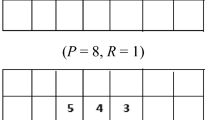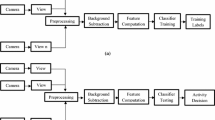Abstract
In recent years, physical violence detection has become a research hotspot in the area of human activity recognition. With the improvement and full coverage of surveillance systems, automatic physical violence detection becomes possible, which can continuously analyze human behavior in the scene, and greatly liberate human resources. This paper proposes a physical violence detecting method based on distributed surveillance cameras. The cameras capture images, and extract human bone models with an improved OpenPose model. All the surveillance cameras form an Ad hoc network, and transfer the extracted bone models to the monitoring center. Aiming at the problem of missing bone points caused by occlusion, this paper proposes a key point filling algorithm to improve the bone models. Then the monitoring center extracts morphological features and dynamic features from the improved bone models, and filters them with an improved Relief-F algorithm. SVM (Support Vector Machine) performs classification, and gets an average recognition accuracy of 94.2%.











Similar content being viewed by others
Data availability
The video data were recorded by the authors’ research group.
Code availability
The code is custom code.
References
Shuai H, Yi Z, Weixiao M, Cheng L, Zhensheng Z (2019) Full-duplex relay-assisted macrocell with millimeter wave backhauls: framework and prospects. IEEE Network 33(5):190–197
Liu X, Zhang X (2020) NOMA-based resource allocation for cluster-based cognitive industrial Internet of things. IEEE Trans Industr Inf 16(8):5379–5388
Liu X, Zhai X, Lu W, Wu C (2021) QoS-guarantee resource allocation for multibeam satellite industrial internet of things with NOMA. IEEE Trans Industr Inf 17(3):2052–2061
Liu X, Zhang X (2019) Rate and energy efficiency improvements for 5G-based IoT with simultaneous transfer. IEEE Internet Things J 6(4):5971–5980
Ye L, Shi J, Ferdinando H, Seppänen T, Alasaarela E (2020) A multi-sensor school violence detecting method based on improved relief-F and D-S algorithms. Mobile Netw Appl 25(5):1655–1662
Anitha U et al (2020) Robust human action recognition system via image processing. Procedia Comput Sci 167:870–877
Darwish HW, Bakheit AH, Al SNS et al (2020) Development of innovative artificial neural networks for simultaneous determination of lapatinib and foretinib in human urine by micellar enhanced synchronous spectrofluorimetry. Spectrochim Acta Part A Mol Biomol Spectrosc 11(04):238–239
Accattoli, Sernani, Falcionelli et al (2020) Violence detection in videos by combining 3D convolutional neural networks and support vector machines. Appl Artif Intell 34(4):202–203
Shakil AS, Raihan G, Niyaz BH et al (2020) Violence detection by pretrained modules with different deep learning approaches. Vietnam J Comput Sci 07(01):22–23
Hammami SM, Alhammami M (2020) Vision-based system model for detecting violence against children. MethodsX 02(04):7–8
Abdourrahmane MA, Alexandre B, Patrick L (2020) Timed-image based deep learning for action recognition in video sequences. Pattern Recognit 9(03):104–105
Tu Z, Li H, Zhang D et al (2019) Action-Stage Emphasized Spatiotemporal VLAD for Video Action Recognition. IEEE Trans Image Process 28(6):2799–2812
Ji Y, Yang Y, Shen F et al (2021) Arbitrary-view human action recognition: a varying-view RGB-D action dataset. IEEE Trans Circuits Syst Video Technol 31(1):289–300
Wang H, Yu B, Xia K et al (2021) Skeleton edge motion networks for human action recognition. Neurocomputing 423:1–12
Liu J, Zhang R et al (2021) Video action recognition with visual privacy protection based on compressed sensing. J Syst Archit 113:101882
Acknowledgements
This research was funded by National Natural Science Foundation of China under grant number 41861134010.
Funding
This research was funded by National Natural Science Foundation of China under grant number 41861134010.
Author information
Authors and Affiliations
Corresponding author
Ethics declarations
Ethics approval
The actors and actresses in the figures have all agreed that their images can be published in this paper.
Conflicts of interest
The authors declare that there is no conflicts of interest.
Additional information
Publisher's note
Springer Nature remains neutral with regard to jurisdictional claims in published maps and institutional affiliations.
Rights and permissions
About this article
Cite this article
Ye, L., Yan, S., Zhen, J. et al. Physical Violence Detection Based on Distributed Surveillance Cameras. Mobile Netw Appl 27, 1688–1699 (2022). https://doi.org/10.1007/s11036-021-01865-8
Accepted:
Published:
Issue Date:
DOI: https://doi.org/10.1007/s11036-021-01865-8




